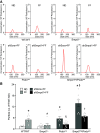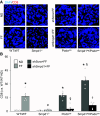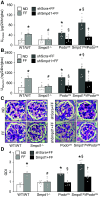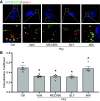Podocyte-specific silencing of acid sphingomyelinase gene to abrogate hyperhomocysteinemia-induced NLRP3 inflammasome activation and glomerular inflammation
- PMID: 38634138
- PMCID: PMC11380990
- DOI: 10.1152/ajprenal.00195.2023
Podocyte-specific silencing of acid sphingomyelinase gene to abrogate hyperhomocysteinemia-induced NLRP3 inflammasome activation and glomerular inflammation
Abstract
Acid sphingomyelinase (ASM) has been reported to increase tissue ceramide and thereby mediate hyperhomocysteinemia (hHcy)-induced glomerular nucleotide-binding oligomerization domain-like receptor containing pyrin domain 3 (NLRP3) inflammasome activation, inflammation, and sclerosis. In the present study, we tested whether somatic podocyte-specific silencing of Smpd1 gene (mouse ASM gene code) attenuates hHcy-induced NLRP3 inflammasome activation and associated extracellular vesicle (EV) release in podocytes and thereby suppresses glomerular inflammatory response and injury. In vivo, somatic podocyte-specific Smpd1 gene silencing almost blocked hHcy-induced glomerular NLRP3 inflammasome activation in Podocre (podocyte-specific expression of cre recombinase) mice compared with control littermates. By nanoparticle tracking analysis (NTA), floxed Smpd1 shRNA transfection was found to abrogate hHcy-induced elevation of urinary EV excretion in Podocre mice. In addition, Smpd1 gene silencing in podocytes prevented hHcy-induced immune cell infiltration into glomeruli, proteinuria, and glomerular sclerosis in Podocre mice. Such protective effects of podocyte-specific Smpd1 gene silencing were mimicked by global knockout of Smpd1 gene in Smpd1-/- mice. On the contrary, podocyte-specific Smpd1 gene overexpression exaggerated hHcy-induced glomerular pathological changes in Smpd1trg/Podocre (podocyte-specific Smpd1 gene overexpression) mice, which were significantly attenuated by transfection of floxed Smpd1 shRNA. In cell studies, we also confirmed that Smpd1 gene knockout or silencing prevented homocysteine (Hcy)-induced elevation of EV release in the primary cultures of podocyte isolated from Smpd1-/- mice or podocytes of Podocre mice transfected with floxed Smpd1 shRNA compared with WT/WT podocytes. Smpd1 gene overexpression amplified Hcy-induced EV secretion from podocytes of Smpd1trg/Podocre mice, which was remarkably attenuated by transfection of floxed Smpd1 shRNA. Mechanistically, Hcy-induced elevation of EV release from podocytes was blocked by ASM inhibitor (amitriptyline, AMI), but not by NLRP3 inflammasome inhibitors (MCC950 and glycyrrhizin, GLY). Super-resolution microscopy also showed that ASM inhibitor, but not NLRP3 inflammasome inhibitors, prevented the inhibition of lysosome-multivesicular body interaction by Hcy in podocytes. Moreover, we found that podocyte-derived inflammatory EVs (released from podocytes treated with Hcy) induced podocyte injury, which was exaggerated by T cell coculture. Interstitial infusion of inflammatory EVs into renal cortex induced glomerular injury and immune cell infiltration. In conclusion, our findings suggest that ASM in podocytes plays a crucial role in the control of NLRP3 inflammasome activation and inflammatory EV release during hHcy and that the development of podocyte-specific ASM inhibition or Smpd1 gene silencing may be a novel therapeutic strategy for treatment of hHcy-induced glomerular disease with minimized side effect.NEW & NOTEWORTHY In the present study, we tested whether podocyte-specific silencing of Smpd1 gene attenuates hyperhomocysteinemia (hHcy)-induced nucleotide-binding oligomerization domain-like receptor containing pyrin domain 3 (NLRP3) inflammasome activation and associated inflammatory extracellular vesicle (EV) release in podocytes and thereby suppresses glomerular inflammatory response and injury. Our findings suggest that acid sphingomyelinase (ASM) in podocytes plays a crucial role in the control of NLRP3 inflammasome activation and inflammatory EV release during hHcy. Based on our findings, it is anticipated that the development of podocyte-specific ASM inhibition or Smpd1 gene silencing may be a novel therapeutic strategy for treatment of hHcy-induced glomerular disease with minimized side effects.
Keywords: NLRP3 inflammasome; acid sphingomyelinase; extracellular vesicle; hyperhomocysteinemia; podocyte.
Conflict of interest statement
No conflicts of interest, financial or otherwise, are declared by the authors.
Figures












References
-
- Yamasaki K, Muto J, Taylor KR, Cogen AL, Audish D, Bertin J, Grant EP, Coyle AJ, Misaghi A, Hoffman HM, Gallo RL. NLRP3/cryopyrin is necessary for interleukin-1β (IL-1β) release in response to hyaluronan, an endogenous trigger of inflammation in response to injury. J Biol Chem 284: 12762–12771, 2009. doi:10.1074/jbc.M806084200. - DOI - PMC - PubMed
MeSH terms
Substances
Grants and funding
LinkOut - more resources
Full Text Sources
Molecular Biology Databases

